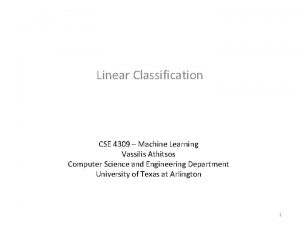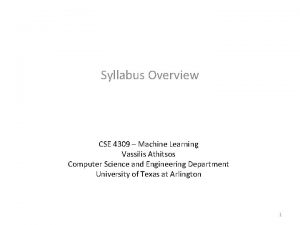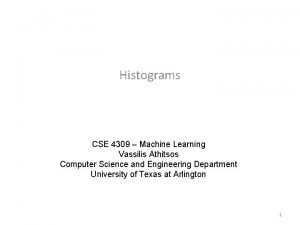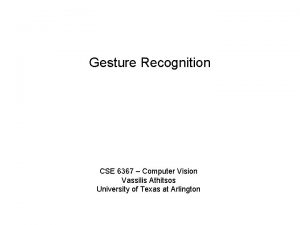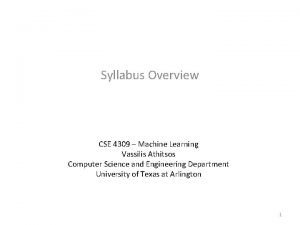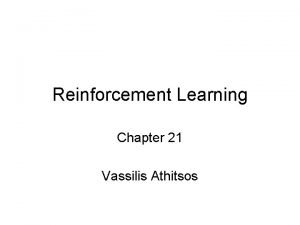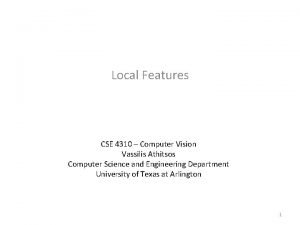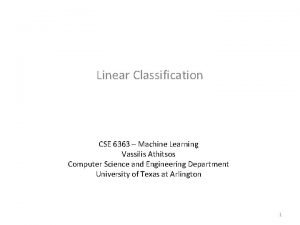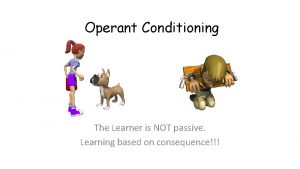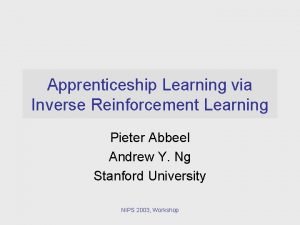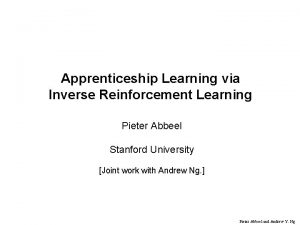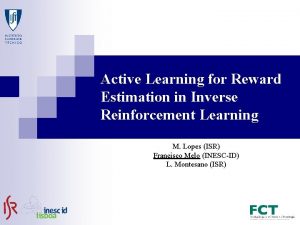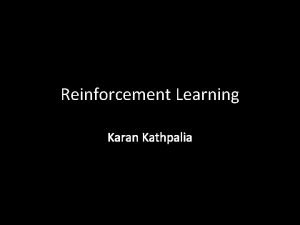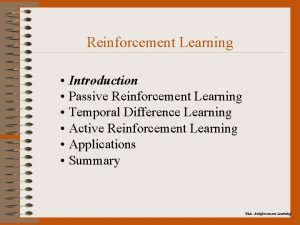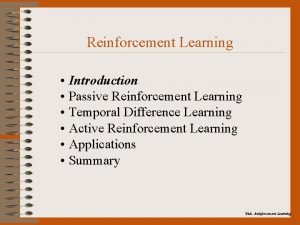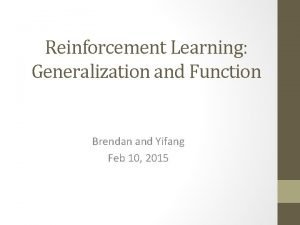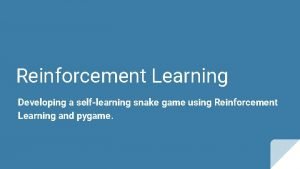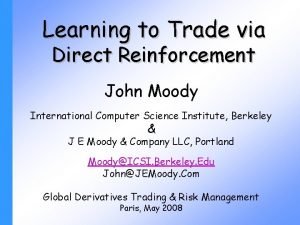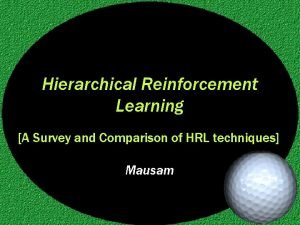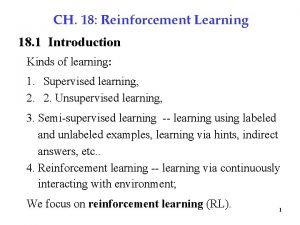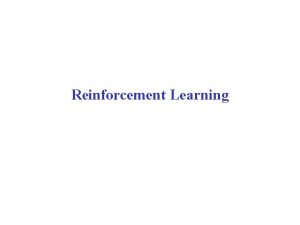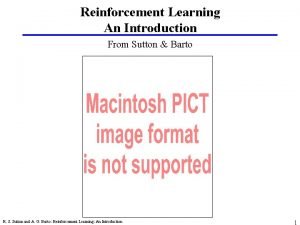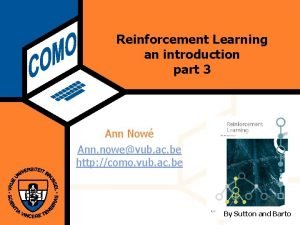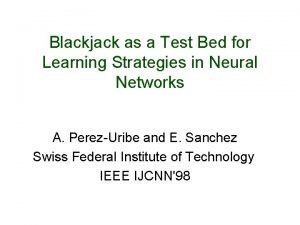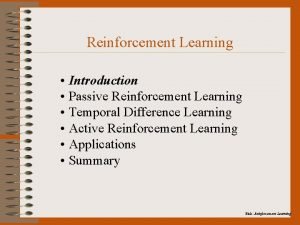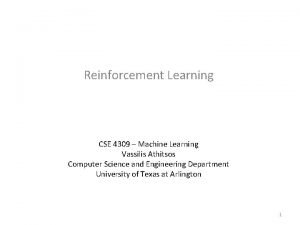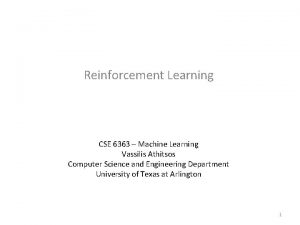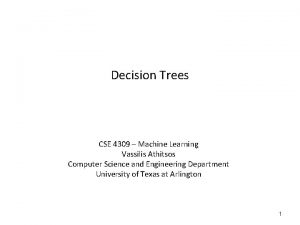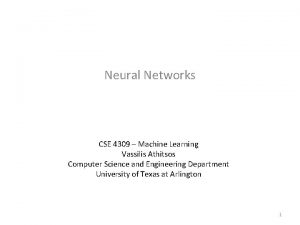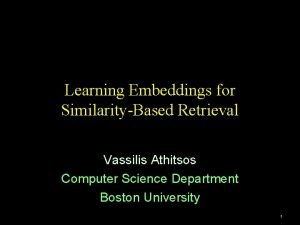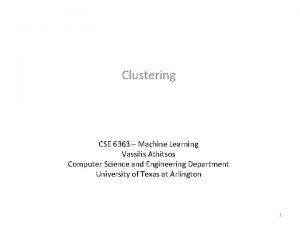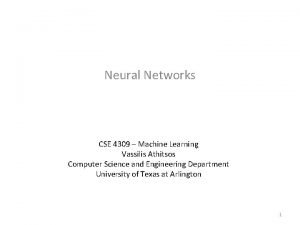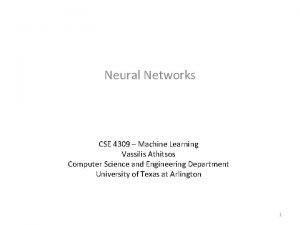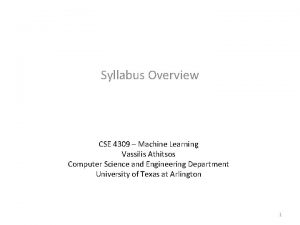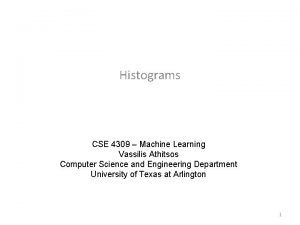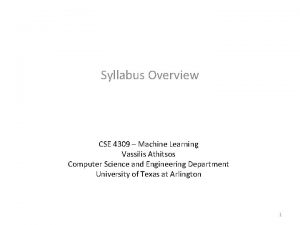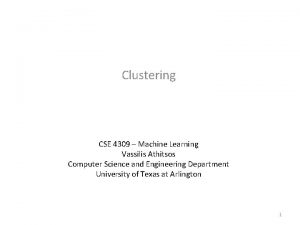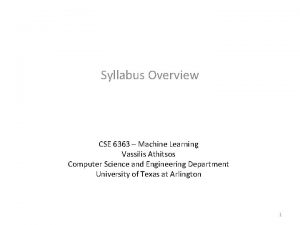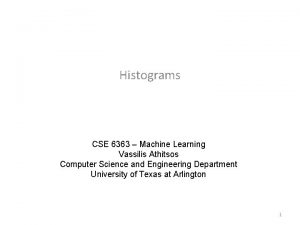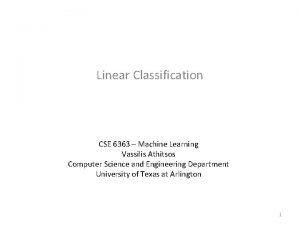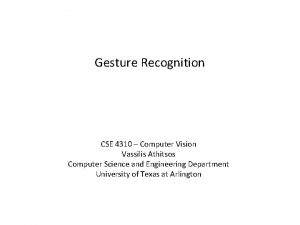Reinforcement Learning Chapter 21 Vassilis Athitsos Reinforcement Learning











![Properties of Temporal Difference • What happens when an unlikely transition occurs? – U[s] Properties of Temporal Difference • What happens when an unlikely transition occurs? – U[s]](https://slidetodoc.com/presentation_image_h/0e18f6210cdae24022a73b4b626c955b/image-12.jpg)







![Exploration Function • U[s] = R[s] + g max {f(Q(a, s), N(a, s))}. R[s]: Exploration Function • U[s] = R[s] + g max {f(Q(a, s), N(a, s))}. R[s]:](https://slidetodoc.com/presentation_image_h/0e18f6210cdae24022a73b4b626c955b/image-20.jpg)
![Q-learning • Learning utility of state-action pairs. U[s] = max Q(a, s). • Learning Q-learning • Learning utility of state-action pairs. U[s] = max Q(a, s). • Learning](https://slidetodoc.com/presentation_image_h/0e18f6210cdae24022a73b4b626c955b/image-21.jpg)





- Slides: 26

Reinforcement Learning Chapter 21 Vassilis Athitsos

Reinforcement Learning • In previous chapters: – Learning from examples. • Reinforcement learning: – Learning what to do. • Learning to fly (a helicopter). • Learning to play a game. • Learning to walk. – Learning based on rewards.

Relation to MDPs • Feedback can be provided at the end of the sequence of actions, or more frequently. – Compare chess and ping-pong. • No complete model of environment. – Transitions may be unknown. • Reward function unknown.

Agents • Utility-based agent: – Learns utility function on states. • Q-learning agent: – Learns utility function on (action, state) pairs. • Reflex agent: – Learns function mapping states to actions.

Passive Reinforcement Learning • Assume fully observable environment. • Passive learning: – Policy is fixed (behavior does not change). – The agent learns how good each state is. • Similar to policy evaluation, but: – Transition function and reward function or unknown. • Why is it useful?

Passive Reinforcement Learning • Assume fully observable environment. • Passive learning: – Policy is fixed (behavior does not change). – The agent learns how good each state is. • Similar to policy evaluation, but: – Transition function and reward function or unknown. • Why is it useful? – For future policy revisions.

Direct Utility Estimation • For each state the agent ever visits: – For each time the agent visits the state: • Keep track of the accumulated rewards from the visit onwards. • Similar to inductive learning: – Learning a function on states using samples. • Weaknesses: – Ignores correlations between utilities of neighboring states. – Converges very slowly.

Adaptive Dynamic Programming • Learns transitions and state utilities. • Plugs values into Bellman equations. • Solves equations with linear algebra, or policy iteration. • Problem:

Adaptive Dynamic Programming • Learns transitions and state utilities. • Plugs values into Bellman equations. • Solves equations with linear algebra, or policy iteration. • Problem: – Intractable for large number of states. • Example: backgammon. – 1050 equations, with 1050 unknowns.

Temporal Difference • Every time we make a transition from state s to state s’: – Update utility of s’: U[s’] = current observed reward. – Update utility of s: U[s] = (1 -a)U[s] + a (r + g U[s’] ). a: learning rate r: previous reward g: discount factor

Properties of Temporal Difference • What happens when an unlikely transition occurs?
![Properties of Temporal Difference What happens when an unlikely transition occurs Us Properties of Temporal Difference • What happens when an unlikely transition occurs? – U[s]](https://slidetodoc.com/presentation_image_h/0e18f6210cdae24022a73b4b626c955b/image-12.jpg)
Properties of Temporal Difference • What happens when an unlikely transition occurs? – U[s] becomes a bad approximation of true utility. – However, U[s] is rarely a bad approximation. • Average value of U[s] converges to correct value. • If a decreases over time, U[s] converges to correct value.

Hybrid Methods • ADP: – More accurate, slower, intractable for large numbers of states. • TD: – Less accurate, faster, tractable. • An intermediate approach:

Hybrid Methods • ADP: – More accurate, slower, intractable for large numbers of states. • TD: – Less accurate, faster, tractable. • An intermediate approach: Pseudoexperiences: – Imagine transitions that have not happened. – Update utilities according to those transitions.

Hybrid Methods • Making ADP more efficient: – Do a limited number of adjustments after each transition. – Use estimated transition probabilities to identify the most useful adjustments.

Active Reinforcement Learning • Using passive reinforcement learning, utilities of states and transition probabilities are learned. • Those utilities and transitions can be plugged into Bellman equations. • Problem?

Active Reinforcement Learning • Using passive reinforcement learning, utilities of states and transition probabilities are learned. • Those utilities and transitions can be plugged into Bellman equations. • Problem? – Bellman equations give optimal solutions given correct utility and transition functions. – Passive reinforcement learning produces approximate estimates of those functions. • Solutions?

Exploration/Exploitation • The goal is to maximize utility. • However, utility function is only approximately known. • Dilemma: should the agent – Maximize utility based on current knowledge, or – Try to improve current knowledge.

Exploration/Exploitation • The goal is to maximize utility. • However, utility function is only approximately known. • Dilemma: should the agent – Maximize utility based on current knowledge, or – Try to improve current knowledge. • Answer: – A little of both.
![Exploration Function Us Rs g max fQa s Na s Rs Exploration Function • U[s] = R[s] + g max {f(Q(a, s), N(a, s))}. R[s]:](https://slidetodoc.com/presentation_image_h/0e18f6210cdae24022a73b4b626c955b/image-20.jpg)
Exploration Function • U[s] = R[s] + g max {f(Q(a, s), N(a, s))}. R[s]: current reward. g: discount factor. Q(a, s): estimated utility of performing action a in state s. N(a, s): number of times action a has been performed in state s. f(u, n): preference according to utility and degree of exploration so far for (a, s). • Initialization: U[s] = optimistically large value.
![Qlearning Learning utility of stateaction pairs Us max Qa s Learning Q-learning • Learning utility of state-action pairs. U[s] = max Q(a, s). • Learning](https://slidetodoc.com/presentation_image_h/0e18f6210cdae24022a73b4b626c955b/image-21.jpg)
Q-learning • Learning utility of state-action pairs. U[s] = max Q(a, s). • Learning can be done using TD: Q(a, s) = (1 -b) Q(a, s) + b(R(s) + g max(Q(a’, s’)) b: learning factor g: discount factor s’: next state a’: possible action at next state

Generalization in Reinforcement Learning • How do we apply reinforcement learning problems with huge numbers of states (chess, backgammon, …)?

Generalization in Reinforcement Learning • How do we apply reinforcement learning problems with huge numbers of states (chess, backgammon, …)? • Solution similar to estimating probabilities of a huge number of events:

Generalization in Reinforcement Learning • How do we apply reinforcement learning problems with huge numbers of states (chess, backgammon, …)? • Solution similar to estimating probabilities of a huge number of events: – Learn parametric functions, where parameters are features of each state. • Example: chess. – 20 features adequate for describing the current board.

Learning Parametric Utility Functions For Backgammon • First approach: – Design weighted linear functions of 16 terms. – Collect training set of board states. – Ask human experts to evaluate training states. • Result: – Program not competitive with human experts. – Collecting training data was very tedious.

Learning Parametric Utility Functions For Backgammon • Second approach: – Design weighted linear functions of 16 terms. – Let the system play against itself. – Reward provided at the end of each game. • Result (after 300, 000 games, a few weeks): – Program competitive with best players in the world.
 Vassilis athitsos
Vassilis athitsos Athitsos
Athitsos Vassilis athitsos
Vassilis athitsos Vassilis athitsos
Vassilis athitsos Vassilis athitsos
Vassilis athitsos Passive reinforcement learning
Passive reinforcement learning Vassilis athitsos
Vassilis athitsos Vassilis athitsos
Vassilis athitsos Awareio
Awareio What is a secondary reinforcer
What is a secondary reinforcer Apprenticeship learning via inverse reinforcement learning
Apprenticeship learning via inverse reinforcement learning Apprenticeship learning via inverse reinforcement learning
Apprenticeship learning via inverse reinforcement learning Inverse reinforcement learning
Inverse reinforcement learning Karan kathpalia
Karan kathpalia Passive reinforcement
Passive reinforcement Passive and active reinforcement learning
Passive and active reinforcement learning Bootstrapping machine learning
Bootstrapping machine learning Snake game reinforcement learning github
Snake game reinforcement learning github Direct reinforcement
Direct reinforcement Hierarchical reinforcement learning: a comprehensive survey
Hierarchical reinforcement learning: a comprehensive survey What is optimal policy in reinforcement learning
What is optimal policy in reinforcement learning Wsbgixdc9g8 -site:youtube.com
Wsbgixdc9g8 -site:youtube.com Reinforcement learning exploration vs exploitation
Reinforcement learning exploration vs exploitation Sutton blackjack
Sutton blackjack Jack's car rental reinforcement learning
Jack's car rental reinforcement learning Neural network blackjack
Neural network blackjack What is active and passive reinforcement learning
What is active and passive reinforcement learning
